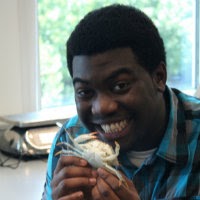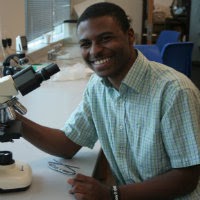2013 Student Participants

Amanda Alvarez, Bradley Stevens, Daniel Cullen, and Ronald Tardiff
Sex ratios of Black sea bass, Centropristis striata, in the northern Atlantic Ocean
This study examined sexual succession of black sea bass, Centropristis striata, in the northern Atlantic Ocean. Samples were taken over a period of three weeks after which the fish were brought back to the lab for processing. Initial macroscopic sexing was inadequate in determining transitional fish due to many of the originally classified female samples containing male tissue and thereby being classified as transitional. From the data collected in this study, we speculate that transition tends to occur when the fish are between 19 and 32 cm in length.

Daniel Hernandez, Mao Miaohua, and Xia Meng
Bay assessment of Chincoteague Bay was made for the years of 2008 to 2011
Ratios were taken for the four years of dissolved oxygen to total nitrogen, total phosphorus and Chlorophyll-a. Monthly data could not be retrieved for Total nitrogen or total phosphorus so analysis had to be made of Chlorophyll-a, wind speed, and direction. Ekman Spiral and transport phenomenon was used to describe possible situations of degrading levels of dissolved oxygen in the Chincoteague Bay and reason for reduced threshold scores.

Remy Jones, Salina Parveen, and Salah Elbashir
Prevalence and Antimicrobial Susceptibility of Salmonella Isolated From Fresh Shrimp
The overall goal for this research is to analyze Salmonella in fresh shrimp. To achieve this objective, twenty samples of 1/2lb-1 lb. of fresh shrimp will be purchased from the local grocery market. Twenty-five grams of the shrimp of each sample will be added in 225 ml of lactose broth for enrichment, then blended and added to RV broth, then incubated, after incubation the culture will be streaked on Xylose Lysine Desoxycholate agar plateagar supplemented with Tergitol 4 (T4) (XLT4), incubated, then evaluated for the presence ofSalmonella using BAX PCR. In addition, Salmonella isolates will be tested for antimicrobial resistance.

Matthew Maxwell and Eric May
Determination of Vitellogenin in White Perch as a biomarker of exposure to estrogenic compounds
The purpose of our study is to determine the presence of Vitellogenin in the liver of the male white perch, using it as a biomarker of exposure to estrogenic compounds. A total of 180 fish were collected; 60 from the Corsica River (reference site), 60 from the Magothy River and 60 from the Nanjemoy River. The weight, length and sex of the fish were recorded. Each of these sites experience different land use, which is the leading factor for these estrogenic compounds being present in the water. A vast amount of agricultural activity takes place on the Corsica River, the Magothy River experiences urban activity, while the Nanjemoy River is mostly forested. Based on the land use at each site, the estrogenic compounds vary, which also means that level of exposure and the concentration of Vitellogenin in each fish will be different.

Erik Mobley, Alexander Nyarko, and Nianhong Chen
Analysis of Heavy Metal concentrations in the Maryland Coastal Bays
Heavy metals (Cu, Hg, Cr, Co, Cd etc.) are potentially harmful/toxic elements to organisms even at relatively low concentrations. Heavy metal pollution is commonly associated with areas of intensive industry. However, roadways and automobiles now are considered to be one of the largest sources of heavy metals. Heavy metal pollution in coastal water has been increased due to urbanization.
Heavy metal concentration in various aquatic environments is important indicator of water quality, and has been widely monitored and studied in both freshwater and seawater. Inductively Coupled Plasma/Mass Spectrometry (ICP/MS) has been widely used for analysis of metals in water samples. However, in seawater, the application of ICP/MS is limited due to interference and matrix effect from high concentration of salt (Na, Cl, K, Ca etc.) In this research we will examine the use of Chelex-100 chelating ion exchange resin to enrich heavy metals and separate them from the interfering substances in water samples of Maryland Coastal Bays. The processed samples can be analyzed directly by ICP/MS. Level of dissolved and/or particulate heavy metal in samples collected from pre-designed sites in MCBs will be measured to examine potential toxicity of heavy metals in the MCB water.

Patricia Perez and Andrea Johnson
Immune System Response to Hypoxia on the Atlantic croaker in the Chesapeake Bay, MD
The problem of hypoxia has been a growing one in the Chesapeake Bay, especially in the summer months of July and August. Natural factors contribute to this problem along with anthropogenic factors. Atlantic croaker (Micropogonias undulatus) are estuarine-dependent demersal species of commercial and recreational importance in the Chesapeake and a good indicator species to monitor the health of the Bay. The croakers were used to assess the immune system response to hypoxia using differential leukocyte counts and a phagocytosis assay. Croaker were collected from both normoxic sites and hypoxic sites of the Bay. Fish were sampled immediately onboard with further analysis done at the Fish Research Lab at UMES.

Adrian Plummer and Joseph Pitula
Cloning Potential Candidates for Genes that Code for Protein Kinase C in Perkinsus marinus
The purpose of this study is to clone genetic sequences that code for a predicted protein kinase C (PKC) isoform. Bioinformatics were used to create primers to target sequences that were believed to code for protein kinase C. PCR was used to amplify the select sequences, then the PCR products were ligated into separate plasmid vectors. The plasmids were inserted into competent E. coli cells for cloning and then purified from the cells. 3 gene products were generated through the cloning process, and are awaiting sequencing from the Institute of Marine and Environmental Technology in Baltimore.

Even Reeves and Eric May
Estrogenic effluents effect on sex ratios in White Perch
Effluents that lead into the Chesapeake Bay from the Magothy, Middle, Corsica, and Sassafras rivers may contain environmental estrogens (EEs) (Sonnenschein and Soto, 1998). Estrone, estriol, and estradiol are three major estrogenic hormones that could be affecting sex ratios of White Perch (Morone Americana) near/in the Chesapeake Bay and turning some male White Perch into transsexual individuals. This project will discover if there are any differences in sex ratios between two urbanized rivers (Magothy and Middle), two agricultural rivers (Corsica and Sassafras), and two natural rivers (Honga and Rhode). Early detection of estrogenic effluent levels can ultimately be the difference between endangering the species of animals that occupy the Chesapeake Bay, and helping those species thrive.

Ronald Tardiff, Daniel Cullen, Bradley Stevens, and Amanda Alvarez
Size-related variation in black sea bass diet
The purpose of this study was to identify the feeding habits of black sea bass off the coast of Maryland. This study sought to generate indices that compare diet with body size and gender to determine if a diet shift occurs with increasing body size. Fish were collected through angling off the coast of Maryland during the summer of 2013. Stomach content between large and small fish was compared. A comparison showed that diet was not independent of size.
Krizia Chambers and Paulinus Chigbu
Seasonal and temporal patterns in phytoplankton biomass in chlorophyll in Maryland Coastal Bays
Dissolved organic matter or DOM compositing and dynamics in temperate shallow coastal bays are not well described although these very same bays may be important as local sources of organic carbon to ocean waters and are often sites of pivotal economic fisheries and aquacultures. In this experiment water samples were collected from depths from zero meters to two meters on a trimonthly basis from years 1985 till 2012 from the mid Atlantic coastal bay (Chincoteague Bay, Virginia and Maryland, USA).
A possible linkage may exist between biological patchiness and hydrodynamic mixing events. This was investigated by measuring the spatial and temporal variations in chlorophylla,temperature, and wind events. The hypothesis is that during periods of cool temperatures and high wind velocities the water column is unstable and deep nutrient rich water is more likely to mix with the epilimnion bringing useful nutrients to phytoplankton in the euphotic zone. The mixing due to internal waves may be a controlling factor for higher chlorophylla concentrations, higher turbidity levels and lower Secchi disc transparency throughout the first 60 meters.
Chlorophylla may have a possible link to meteorological processes such as wind speed and water temperature. By comparing the chlorophylla values at sites chosen intentionally with different spatial locations, different distances from shore and different vertical depths in the pelagic, a possible link is suggested from observations of extreme wind events, water temperature anomalies and the changes seen in the chlorophylla levels. High winds and cold temperatures cause less stratified water, which allows the epilimnion to mix, bringing nutrients to the surface and possibly raising chlorophyll a values.
Lauren Malinis and Paulinus Chigbu
Abundance and Distribution of Brown Shrimp, White Shrimp, and Sand Shrimp in the Maryland Coastal Bays
The abundance of brown shrimp, white shrimp, and sand shrimp in relation to interannual variations in climatic factors have been examined in other regions. However, no such study has been conducted in the Maryland Coastal Bays. Research conducted on shrimp and their response to water quality has often been done in labs and this project may allow us to see if wild shrimp in the coastal bays follow the same patterns. It would be interesting to observe the populations and their response to aspects of water quality such as amount of dissolved oxygen, temperature, and salinity in coastal bay habitats.
We hypothesize that the (1) abundance of all the three shrimp species will be low during years of relatively low temperatures, and (2) abundance will be high during years of years of relatively high precipitation, and when dissolved oxygen levels of the water are relatively high.
Tonisha Patton and Maggie Sexton
Effects of environmental conditions on Chrysaora quinquecirrhaephyra abundance
Understanding environmental conditions in which each stage of the sea nettle Chrysaora quinquecirrha life cycle can thrive is necessary to best predict when and where they will be located. Most of jellyfish research is conducted on the medusa stage, but not much is known about the ephyra stage, which is the first free-swimming form. Past research examined the causes of medusa blooms and their disappearance, but little is known about the effects of environmental conditions on ephyrea. In this Chysasora quinquecirrha ephyra abundance and several environmental conditions were measured and examined for environment effects on ephyra abundance. Patterns in ephyra abundance was compared to medusa abundance.
Alexandria Thompson, Kwame Nyame, Olatunji Kosile, Msano Mandalasi
Study of Expression of Terminal O-linked GlcNAc by Developing Schistosoma mansoni
Approximately 30 years ago the enzyme O-GlcNAc was discovered, but many scientist today still overlook it because the enzyme is very small4, 6. An increase in O-GlcNAc has been found in all mammals that have been tested as one of the earliest responses to cellular stress4. The O-GlcNAc enzyme mediates stress tolerance in part by altering the levels of heat-shock proteins (HSPs) 7. This is why we believe that the proteins found in the parasiteSchistosoma mansoni are terminal O-linked GlcNAc because the parasite undergoes temperature and salinity changes that should shock the parasite and kill it. However the S. mansoni does not die. Therefore to prove that theS. mansoni has the O-GlcNAc enzyme a western blot must be performed because that is the only way to see the small enzyme.


